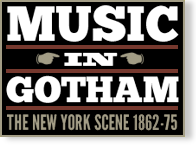Rubinstein-Wienawski Chamber Concert: 3rd
Event Information
Venue(s):
Steinway Hall
Manager / Director:
Maurice Grau
Price: $1; $2 reserved seat
Event Type:
Chamber (includes Solo)
Record Information
Status:
Published
Last Updated:
22 January 2025
Performance Date(s) and Time(s)
15 Nov 1872, EveningPerformers and/or Works Performed
Citations
“The third of the chamber concerts by Messrs. Rubinstein and Wieniawski was given at Steinway Hall last night before one of the best audiences we have ever seen attracted in New-York by this class of music. It is music which appeals to a highly cultivated taste, and demands of the listener close attention and a great deal of thought. It has never been popular with the general public, and the interest excited by it now is due, we suspect, more to the fame of the two principal performers than to an increased appreciation of the compositions. The selections last night were [see above]. Mr. Matzka played the second violin in the quartet, and Mr. Goffrie the viola, and Mr. Bergner was the violoncellist. The Schubert trio was admirable. The tendency of the two star players to predominate unduly over their associates was very little perceptible, and the execution in general was highly sympathetic, elegant, and carefully finished. Of course it was a rare treat to hear the piano and violin parts so superbly handled as they were by Messrs. Rubinstein and Wieniawski, and Mr. Bergner was not unworthy of the high company in which he found himself. The Haydn quartet was more remarkable for the exquisite delicacy and grace of some of the first violin passages than for any remarkable merit in the performance as a whole. It showed that the best artists cannot give string quartets their full beauty unless they have practiced long together, and learned not merely to follow the music, but to follow one another’s thoughts. Mr. Rubinstein’s trio, being strongly colored by the piano part, made a deeper impression than the other pieces, and one movement was actually encored. It opens with a charming melody, written in the classical style, and passes into a remarkably original and forcible theme, which the composer treats in his most magnificent manner. The strings become little more to be sure than an accompaniment for the piano, but handled as the three instruments were last night the effect was superb. A few performances like these would make chamber music one of the most popular forms of entertainment.
Mlle. Liebhart diversified the programme with three songs. A matinée today will bring the series of chamber music concerts to a close. It has been a valuable one, and Mr. Grau—if he was the originator of it—deserves the thanks of all connoisseurs.”
“There were three notable works played at Steinway Hall last night. Two trios, one in B flat by Schubert and one in G minor by Rubinstein, were rendered by Rubinstein, Wieniawski and Bergner. A string quartet of Haydn, in D major, brought forward Wieniawski, Matzka, Goffrie and Bergner. The last mentioned work was the weakest point of performance on the bill. This was owing to the preponderance of the leading violin over the others. A quartet of Haydn is written with such a nicety of balance in all the parts that there is not the slightest chance for mere virtuoso display. Therefore when M. Wieniawski attempts to make, or rather, through the weakness of his assistants, succeeds in making himself the only feature of such a work, the purpose and idea of the composer are completely lost. It was otherwise with the trios. It would be but a repetition of what has already appeared in these columns to refer in detail to the effect of Rubinstein and Wieniawski’s playing, and when this is supplemented by such a consummate local artist as Fred Bergner it is only necessary to say that each trio, especially the brilliant work of Rubinstein, received ample justice. In chamber music there is a great difference between the playing of three such artists as Rubinstein, Wieniawski and Bergner as when inferior performers are called upon to assist them. The great principle of chamber music is in an equipoise of tone, expression and feeling, and, with the sole exceptions of Mr. Bergner and Dr. Damrosch, it is very difficult to point towards another artist to be placed side by side in this city with the Russian pianist and the Polish violinist as artistic exponents of this the highest and most aesthetic form of music.”

